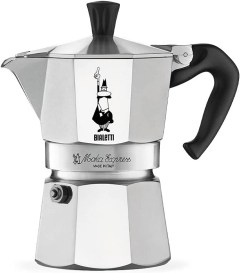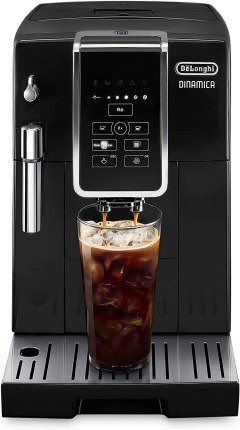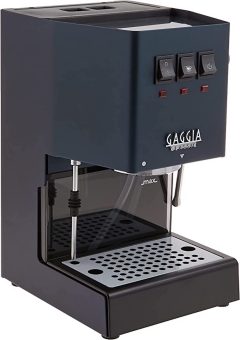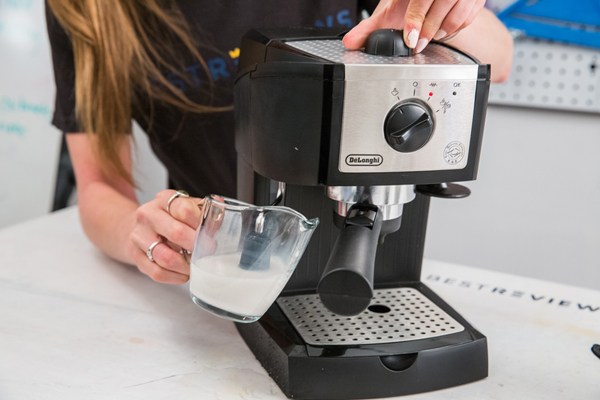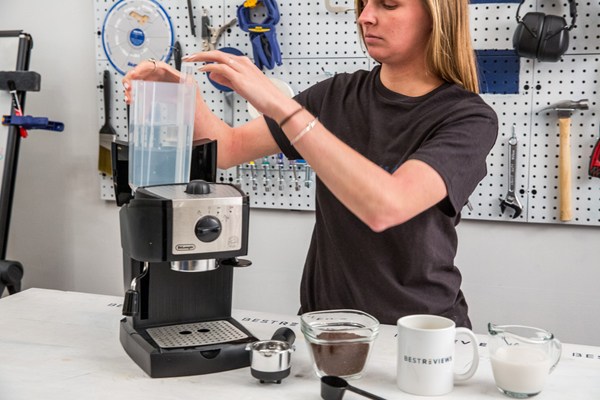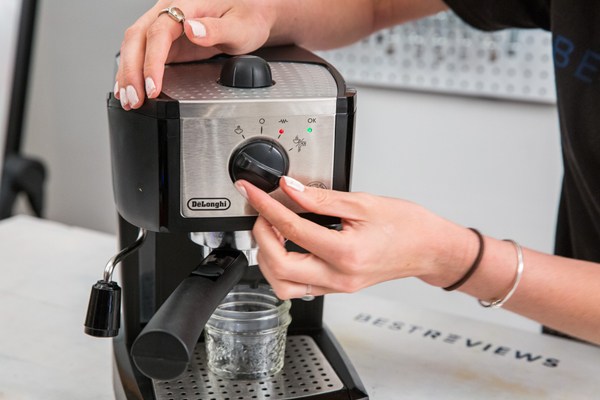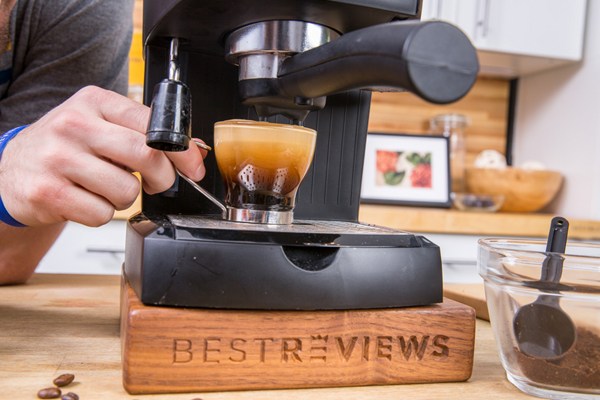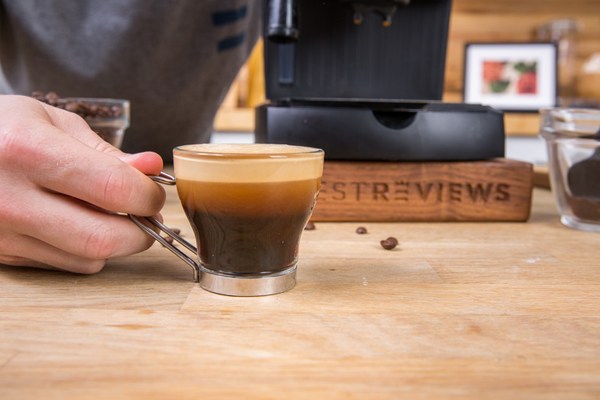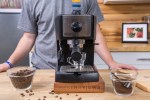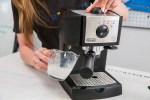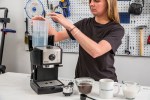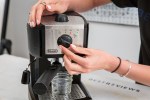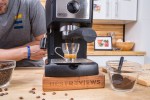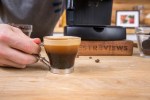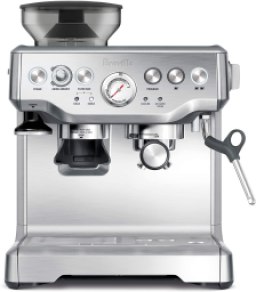Buying guide for Best espresso machines
For many people, using an espresso machine in the morning is the next best thing to visiting a barista daily. The BestReviews Testing Lab considered 33 machines before deciding on the five best espresso machines. We graded each one on its ease of use, range of features and whether it produced a consistent flavor.
We began our testing by setting each model up, determining how easy the process was and whether the average person would need the manual. We timed each espresso maker as they pulled the espresso to see how quickly they got the job done. We used them several times daily throughout the week, and sometimes over the course of a month, to get a feel for their operation and programmable functions.
If the machine had special features, such as a milk frother or bean grinder, we scrutinized them with each use to determine whether they produced consistent results. We tasted each cup of espresso we pulled to determine whether the flavor was consistent. Finally, we cleaned the machines to understand how easy they were to maintain. After completing our tests, we concluded the Breville Barista Express is the best espresso machine overall.
Our list: The best espresso makers
Breville Barista Express
Best espresso machine overall
Specifications: Dimensions: 12 x 11 x 13.5 inches | Water tank capacity: 67 ounces | Materials: Brushed stainless steel | Pressure: 9 bars | Milk Frother: Yes
The Breville Barista Express arrived well-packaged. It was wrapped in plastic to keep the chrome finish from getting damaged. It’s a heavy espresso maker with a durable, stylish design. It’s easy to set up, although the process felt a bit tedious. We had to wash each detachable piece and run a full tank of hot water through the lines to clean them.
This machine has a bit of a learning curve. We had to learn how to properly tamp the grounds and remember to follow Breville’s recommended instructions, including preheating the portafilter and basket and drying them before each use. The grinder does a great job of grinding beans, but you have to pay attention to ensure they’re properly fed into it by the hopper. Despite the learning curve and tricky brew process, we were amazed by how well it brews espresso once we got the hang of it.
Each cup’s flavor was consistently delicious, and the steam wand was easy to use. After brewing an espresso, we simply wiped the machine and steam wand with a damp cloth and ran the steam wand for a few seconds to flush out the stem.
The Breville Barista Express wins our best-of-the-best spot for its stylish design and incredible results. This isn’t the best espresso machine for beginners, but those looking to emulate a cafe-quality experience at home are sure to love it.
Bialetti Moka Express
Best cheap espresso maker
Specifications: Dimensions: 5 x 5 x 5 inches | Water tank capacity: 3 cups | Materials: Aluminum | Pressure: 2 bars | Milk Frother: No
The Bialetti Moka Express is a moka pot, meaning it brews coffee and espresso on your stovetop with pressurized steam. We used this affordable espresso maker twice a week for roughly a month and were impressed with its results. Still, it’s worth mentioning you need nine bars of pressure for traditional espresso, and the Moka Express can only achieve two bars. Despite this limitation, we found this to be a good budget option for those who don’t want to invest in a top-of-the-line machine.
When brewing espresso with this, we found it best to use coarse grounds. When we used fine grounds like those we’d use with a traditional espresso machine, the steam seemed to have trouble passing through the grounds. We also noticed that it worked best with a gas stove. We could use it with an electric stovetop, but it was hard to regulate the temperature. We simply unscrewed the cap, added coffee grounds to the filter, and added water to use it. It produced consistent results as long as we didn’t let the flame envelope the pot.
There was a bit of a learning curve, but it was straightforward once we identified the ideal grind, temperature, and brew time. We loved that it was easy to clean, not requiring chemical detergents. This was the best cheap espresso machine we tested, thanks to its consistent results and ease of use.
Nespresso Vertuo Next Espresso Machine
Best espresso machine for beginners
Specifications: Dimensions: 5.51 x 14.72 x 12.45 inches | Water tank capacity: 37 ounces | Materials: Plastic | Pressure: 19 bars | Milk Frother: Yes
The Nespresso Vertuo Next is designed to work with Nespresso pods, making it an ideal choice for those looking for convenience. We sampled a variety of pods and found the flavor to be consistently good, although it differed depending on the pod we used. It features a one-button operation and virtually no learning curve.
It’s around the size of a loaf of bread and fits well on medium-sized counters. Cleaning the water tank was straightforward, but we ran into issues early on, as it alerted us the machine needed to be descaled. This was a minor frustration, but we were able to continue using it after treating it with a descaling solution. It brews espresso in around 60 seconds, taking about 20 seconds to warm up, 30 seconds to dispense, and 10 seconds to finish dripping.
We could brew about eight cups of espresso with a full water tank. This was by far the easiest machine to use after navigating the descaling issue.
De'Longhi Dinamica Automatic Coffee & Espresso Machine
Best fully-automatic espresso machine
Specifications: Dimensions: 9.3 x 16.9 x 13.7 inches | Water tank capacity: 60 ounces | Materials: Plastic | Pressure: 15 bars | Milk Frother: Yes
The Dinamica Home Espresso Machine takes up as much space as a traditional coffee maker and has various features that make it stand out. For example, it can brew iced coffee and has a built-in milk frother. We used the iced coffee setting several times and found it does a good job of brewing a strong enough drink to account for some of the ice melting.
The setup process wasn’t as easy as we’d hoped, but the manual did an excellent job guiding us. After getting it set up and cleaned, its operation was incredibly straightforward. It heats up and starts brewing within a few seconds. The automatic grinder was intuitive, letting us manually adjust our settings or use pre-ground coffee. Pulling espresso was just as easy; we recommend using a grind setting between one and three for this.
The milk frother worked with dairy and non-dairy milk, and we used it as a cappuccino maker by combining the brewing and frothing functions. This was the best fully-automatic espresso machine we tested, thanks to its lighting-fast brew time, straightforward operation, and range of features.
Nespresso Vertuo Plus
Best coffee and espresso maker
Specifications: Dimensions: 5.6 x 16.7 x 12.8 inches | Water tank capacity: 37 ounces | Materials: Plastic | Pressure: 19 bars | Milk Frother: Yes
The Nespresso Vertuo Plus has a relatively small footprint and lets you brew coffee or espresso with ease. It’s compatible with Nespresso pods and is designed for single-serve brewing. It also features an adjustable water tank, letting you move it from one side to the other to fit your counter better.
The machine is affordable compared to others, but the cost of the pods can add up over time. Still, the pods are recyclable through the Nespresso recycling program, so you don’t have to worry about your carbon footprint. Most reviewers found this model easy to use, although there are some longevity concerns, as some users claimed this machine stopped working within the first year. Still, these could be isolated issues, as most long-term reviews indicate it stood the test of time.
Types of espresso machines
Espresso machines fall into four main categories: semi-automatic, fully automatic, manual, and super-automatic espresso machines.ines.
Semi-automatic and fully automatic espresso machines are the most popular types on the market today. This is primarily due to their convenience and ease of use. Semi-automatic espresso machines deliver even, hands-free water pressure, and the user decides when to turn the pump on and off. Fully automatic espresso machines regulate the amount of water traveling through the machine; users don't control the pump at all.
Manual espresso machines require more labor. The user must manually push water through the machine. Because of this, results can vary. Experienced espresso makers fare well with this type of machine.
Super-automatic machines do all the hard work for you. These machines often include high-end features, such as a built-in grinding apparatus.
Although not technically espresso machines, French presses and pour-over coffee makers can make espresso. For the best results, use dark coffee grinds or espresso coffee beans to achieve the bold flavor that is the key feature of espresso brews.
We assess the different types of espresso machines and provide information about how each works. There are four types of espresso machines available: fully automatic, semi-automatic, super-automatic, and manual.
When we research a machine, we examine how challenging it is to operate. Is it easy to use, or does it come with a learning curve? Our readers want to know this when shopping for an espresso machine.
In our research, we evaluate the milk frothers of the espresso machines we recommend, analyzing their ability to produce rich froth that’s suitable for various types of coffee beverages.
We look at how well each machine’s portafilter fits into the gasket and check to see if it has a durable, easy-to-grip handle.
Tank size is an important consideration for many of our readers. Models with large tanks make more cups of espresso at once than those with small tanks, but they also take up more space.
When we compile our research, we evaluate each machine’s controls. Those that are easy to understand and operate earn high marks.
We compare machines that work with regular coffee grinds to those that require specialized pods. Some high-end models have a built-in bean grinder, eliminating the need for an additional appliance to prepare beans for brewing.
During testing, we consider the length of time it takes an espresso machine to heat up for brewing. Reaching optimal temperature is important for producing delicious brews, but some models can take 10 minutes or longer.
When searching for the best espresso machines on the market, we look for bonus features such as cool-touch handles, decanters, and measuring marks.
Our research includes comparing the prices of espresso machines and analyzing the features and capabilities available at different price points.
Types of espresso-based coffee drinks
While clever barista pros are always coming up with twists on common coffee staples, the most popular beverages are based on a shot or more of espresso and steamed milk with a layer of foam artistically placed on top.
Cappuccino is among the most popular espresso-based drinks, but with some clever applications of milk and cream, the sky is the limit as to what you can create.
Here’s a look at six of the most popular coffee shop drinks you could be enjoying at home with the help of an espresso machine:
Cappuccino
A double espresso with hot milk and a layer of froth or milk foam, cappuccino is often served with cinnamon or nutmeg sprinkled on top.
Caffè latte
This is espresso with steamed milk. In some areas of Europe, caffè latte is known as café au lait.
Caffè Americano
This strong drink is espresso with hot water added to taste.
Espresso con panna
Literally translated, this Italian culinary delight is espresso with whipped cream.
Flat white
This is steamed milk mixed in over a double shot of espresso.
Macchiato
Order this if you want espresso with just a dollop of steamed milk.
The six beverages above represent the basics. By adding flavored syrups, chocolate, liqueurs, and even tea, a clever home barista could potentially brew a different espresso drink every day of the week.
For the best tasting espresso, make sure your machine’s portafilter, filter basket, and group head are clean and free of old coffee grounds that could cause new brews to take on a bitter flavor.
STAFF
BestReviews
Making espresso: the basics
The ideal espresso is rich, smooth, velvety, and strong. Creating the perfect cup is an art that requires some trial and error.
The steps may vary slightly by machine, but here’s a general list of procedures to follow:
- Obtain some dark-roasted coffee beans. The best varieties hail from Italy.
- Grind the beans down to a powder-like consistency.
- Pour the espresso into the machine’s portafilter. A portafilter is a handle with a small cup holder at the end.
- After the portafilter is filled, use a tamper—a small, flat-edged device—to tamp down, or “flatter,” the grinds.
- Attach the portafilter to the gasket, which locks it into place. Turn the portafilter about 20 degrees counterclockwise until it tightens into place.
- Once the water heats, press the “on” or “start” button. Dark, rich espresso will slowly pour out.
How to serve espresso
If you’re taking an espresso shot, pour the dark goodness into a six-ounce cup and enjoy.
If you’re making a cappuccino, pour the coffee into a slightly larger cup and froth milk. Layer on the steamed milk and top with some froth.
Did you know?
Some espresso machines allow you to manipulate the strength of your espresso with an adjustable pressure gauge and/or multiple frothing settings.
STAFF
BestReviews
Performance and maintenance
Different espresso machines perform in different ways. Some machines make multiple servings, while others brew just one cup at a time. Some machines allow you to prepare more than one type of drink at a time. The size and power of an espresso machine correlate with its required power supply.
In terms of maintenance, more complex machines tend to require more cleaning. Accessories like pumps, boiler setups, and thermostats usually forecast the amount of cleanup and maintenance required over time. Buyers should be aware that machines with plastic outer coatings can crack with repeated use, leading to the need for expensive repairs or even replacement.
The best espresso machine features
Although espresso machines differ from standard coffee makers, they do essentially the same thing: they create rich, dark coffee. But individual models differ in their “ease of use” when it comes to brewing espresso and the amount of control they offer the home barista.
Water tank size
How much espresso do you want to make at once? The size of your machine’s water reservoir impacts the quantity you can produce. The market offers models with tanks large and small. Some models include a filter that removes impurities from the water. What’s more, some machines have a removable water tank for quick and easy refilling.
Bean requirements
Plenty of espresso machines can accommodate “regular” beans, but some machines require specially designed pods. For example, Keurig machines accept pods called K-Kups.
You’ll also notice that some espresso machines have a built-in burr grinder that allows you to create the perfect grind size. However, others require you to grind your beans elsewhere. If you choose an espresso machine that doesn’t have a bean grinder, investing in a stand-alone model is an easy and inexpensive solution.
Heating time
The amount of time it takes a machine to reach the perfect temperature depends on its heating element. High-end machines like those from Breville and De'Longhi often reach their ideal temperature in less than 10 minutes. However, machines from other manufacturers may take longer.
Milk frother
Most quality espresso machines can produce frothy steamed milk to top off coffee brews. While some models have built-in milk frothers, others have a steam wand. Both types of frothers heat the milk, resulting in its frothy finish. Once an espresso beverage is ready, the frother or steam wand deposits the froth into the hot brew for delicious results.
Other features
Decanters with measuring marks, cool-touch handles, and removable drip trays are just a few of the other features you may wish to consider before making a purchase. Read on to learn more about the particular features offered by each product in our product list.
After frothing milk, add it to an espresso beverage immediately so the crema is warm, foamy, and ready to enjoy.
STAFF
BestReviews
Accessories
After choosing the best espresso maker for your needs, consider a few accessories you may need to make the most out of your purchase and easily create delicious coffee beverages.
Burr grinder
This machine offers you control over the consistency of your coffee grind. Consider a burr grinder if uniformity and flavor matter to you when you grind your own coffee beans.
Espresso tamper
An espresso tamper is the perfect accessory for preparing coffee grounds for espresso brewing. This handheld tool gives you precise control over the grinds before the espresso is made.
DID YOU KNOW?
Want to enjoy your espresso in style? Don’t just use any type of cup for serving. Consider an espresso mug. Many have a double-walled construction to resist condensation and handles that stay cool to the touch.
STAFF
BestReviews
How much does an espresso machine cost?
Under $100
You’ll find great espresso machines from established brands in this price bracket. Machines in this range often boast automated features and versatility.
If you want to be daring, you could purchase a stovetop espresso maker for under $25 and take the “old school” approach to creating espresso. The process required here isn’t as simple as automatic machines, but the principle is the same: You heat water through finely-ground coffee. This approach isn’t for amateurs, but it can be a fun experience.
Under $600
A high-quality espresso maker could cost up to $600. If this price gives you pause, consider that a 16-ounce cappuccino from a coffee shop costs around $4. That means that after 150 drinks at home, you’d break even on the cost of the machine.
Over $600
Premium espresso machines that make gourmet brews can be pricey, with some costing $1,000 or more. As we mentioned, the cost of buying coffeehouse beverages can add up, so an expensive machine will pay for itself over time. What’s more, if you are a dedicated coffee connoisseur, think of a luxury espresso maker as an investment in making your favorite beverages from the comfort of your home.
Most espresso machines are versatile. In addition to making espresso, they can also brew cappuccino, latte, macchiato, and other coffee-based beverages.
STAFF
BestReviews
Other espresso machines we considered
There are many quality espresso machines on the market with features to suit different needs. In addition to the models on our shortlist, we found several other quality machines that impressed us.
The Wirsh 15-bar Espresso Machine has a trim design that fits nicely on small countertops. Its sleek stainless steel construction gives it an appealing appearance. The Jura D6 Automatic Coffee Maker is a premium model with proprietary Pulse Extraction technology that produces rich, full-bodied espresso, cappuccino, and other coffee beverages.
The affordable Aeropress Coffee and Espresso Maker uses an immersion brewing process to produce delicious brews with minimal effort. Finally, pro coffee brewers will appreciate the commercial quality of the Gaggia Classic Pro Espresso Machine. It’s surprisingly easy to use despite its advanced features, including single and double-shot baskets and rocker switch controls.
FAQ
Q. How should I care for my espresso machine?
A. After every brewing session, run a shot of water through the machine to keep it clean. Sediment can build up through repeated use. Wipe the exterior of the machine to keep it clean and looking great.
If your machine permits it, you should also perform a clean water backflush every 10 to 15 shots. This requires you to put a stopper in your portafilter to reverse the water flow.
Q. What is a “Red Eye”?
A. It’s a powerful combination of espresso and strong drip coffee. It can be drunk with or without milk or creamer.
Q. I know that Seattle is the nation’s top coffee-drinking city. Where was its first espresso bar?
A. Seattle’s first espresso bar was Cafe Allegro, located near the University of Washington. The owners worked with Starbucks to create the company’s original espresso blend.
Q. What is the difference between an espresso maker and a coffee machine?
A. Coffee makers are inexpensive machines that generally drip hot water over coffee grounds to brew coffee. Espresso machines use pressure to force hot water through the grounds quickly. Lower-pressure machines tend to produce more flavorful espresso, but you generally want at least nine bars of pressure.
Q. What kind of coffee do you use in an espresso machine?
A. Most espresso machines call for finely-ground coffee, allowing the water to extract more aromatic chemicals. You can use regular ground coffee in espresso machines, although most people prefer to grind their own. Freshly-ground coffee beans produce a better flavor, and you’ll have more control over the grounds’ consistency.



